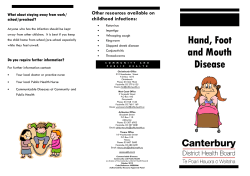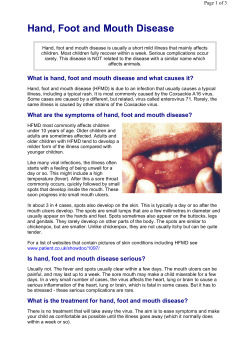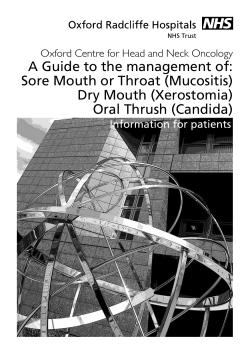
What Is Your Diagnosis?
What Is Your Diagnosis? Author(s): Source: Journal of Avian Medicine and Surgery, 25(1):57-60. 2011. Published By: Association of Avian Veterinarians DOI: 10.1647/2010-058.1 URL: http://www.bioone.org/doi/full/10.1647/2010-058.1 BioOne (www.bioone.org) is an electronic aggregator of bioscience research content, and the online home to over 160 journals and books published by not-for-profit societies, associations, museums, institutions, and presses. Your use of this PDF, the BioOne Web site, and all posted and associated content indicates your acceptance of BioOne’s Terms of Use, available at www.bioone.org/page/terms_of_use. Usage of BioOne content is strictly limited to personal, educational, and non-commercial use. Commercial inquiries or rights and permissions requests should be directed to the individual publisher as copyright holder. BioOne sees sustainable scholarly publishing as an inherently collaborative enterprise connecting authors, nonprofit publishers, academic institutions, research libraries, and research funders in the common goal of maximizing access to critical research. Journal of Avian Medicine and Surgery 25(1):57–60, 2011 ’ 2011 by the Association of Avian Veterinarians What Is Your Diagnosis? History A nestling yellow-billed cuckoo (Coccyzus americanus) of unknown sex was found at the base of a tree, unable to fly, and subsequently was presented to the Wildlife Hospital of Louisiana. On presentation, the cuckoo was bright and alert and weighed 13 g. The bird was in poor body condition (body condition score, 2/5), had incomplete feather growth, and was estimated to be approximately 10% dehydrated. Oral examination revealed an intense red coloring of the oral mucosa, with white nodules on the dorsal surface of the oropharynx and on the tongue (Fig 1). The remainder of the physical examination revealed no other abnormalities. The bird’s behavior was considered typical, and it appeared to have a normal appetite. Initial treatment consisted of subcutaneous fluids (100 mL/kg per day) with feeding every 2 hours of a diet composed of moistened kitten dry food supplemented with calcium carbonate (Fluker’s Calcium with Vitamin D3, Fluker’s, Port Allen, LA, USA) sprinkled on the food. A fresh wet mount from the oropharyngeal nodules was performed. A cotton-tipped applica- Figure 1. Young, yellow-billed cuckoo, showing whitish nodules in the oropharynx during a begging display. tor moistened with warm saline solution was used to sample the areas, after which the swab was rolled onto a microscope slide. The slide preparation was negative for microorganisms on direct microscopic examination. Please evaluate the history, physical examination findings, diagnostic test results, and Figure 1. Formulate a list of differential diagnoses and a treatment plan before proceeding. 57 58 JOURNAL OF AVIAN MEDICINE AND SURGERY Diagnosis A closer examination of the oral cavity with surgical magnification loupes revealed the white markings to be symmetrical in placement and size, with intact underlying mucosa. The areas in question were composed of an arrangement of white papillae. The bird appeared healthy and was gaining weight daily. Another nestling yellow-billed cuckoo was brought in the next week, and it had the same oropharyngeal marking pattern as the bird described above. After 5 weeks of hand-rearing, the 2 cuckoos were released back into the wild. The mouth markings were considered normal for the species. Discussion Cuckoos belong to the family Cuculidae within the order Cuculiformes that also includes the Musophagidae (turacos). The family comprises 136 species and is further divided into 6 subfamilies, namely the Cuculinae (Old World cuckoos), Centropodinae (coucals), the Coccyzinae (American cuckoos), Neomorphinae (New World ground cuckoos), Phaenicophaeinae (malkohas and couas), and Crotophagidae (anis).1 Cuckoos are altricial, and nestling and fledgling cuckoos are identified based on their zygodactyl feet.2 The Coccyzinae comprises 18 species of American cuckoos.1 These cuckoos do not reproduce as a brood-parasite like their Old World counterparts but are nest builders. However, yellow-billed cuckoos sometimes lay eggs in the nests of other species.3 The young of several cuckoo species (including all Coccyzinae) singularize themselves by the presence of white papillate patches in the oropharyngeal cavity (Fig 2).1,3–5 The nestlings of yellow-billed cuckoos have white tomia and a red mouth gape, with the presence of 5 small white papillate patches on the palate, 4 large ones along the caudal part of the choana, 2 on the tongue, and 1 large patch on its dorsal surface (Fig 2).3,5 These conspicuous mouth markings should not be mistaken for lesions, such as those seen with oral trichomoniasis, candidiasis, bacterial stomatitis, viral infection (poxvirus, herpesvirus), oral capillariasis or other nematodes, or squamous metaplasia caused by vitamin A deficiency.6 Most of these conditions can be diagnosed with a fresh wet mount or a gram-stained surface cytologic preparation. A fine-needle aspirate, biopsy, or culture may be needed for a diagnosis in some disease presentations (neoplasia, granulomas). If the normal papillate patches are confused with lesions, then unnecessary diagnostic tests and treatments may be undertaken, with possible iatrogenic adverse effects. Key characteristics of the markings that suggest normality are symmetry as well as the absence of signs of oropharyngeal inflammation. A closer inspection with magnification or the availability of different individuals of the same species can also help in differentiating normal anatomic variation from pathologic lesions. Endoscopic examination of the oral cavity may also provide better details and higher magnification for examination of the oropharynx. In nestlings of altricial birds, the mouth gape is usually brightly colored, and different marking patterns, which disappear when the bird is weaned, may be present, depending on the species. Mouth markings are part of a complex begging display, to stimulate a feeding response and solicit care by the parents.7 Nestling mouth color and markings enhance an adult’s ability to detect nestlings, especially in dark nest sites.7 Mouth color can also signal hunger and quality of the offspring (immune status, general state).7,8 The white papillae of some species of cuckoos may improve their chance of being fed by acting as visual cues for the parents.7,9 Brood-parasitic species of cuckoos also have a complex begging display with different features, including mouth color adaptations, to mimic begging displays of several host species.7,10 In general, brood-parasitic cuckoo nestlings have no mouth marking, whereas species-specific patches are often present in the mouth of nest-builder species.10 In avian medicine, a good knowledge of morphologic and anatomic peculiarities is essential when working with zoological and unusual avian species. The class Aves is the most diverse among the terrestrial vertebrates, with a total number of species close to 10 000.11 Although a general body shape is usually conserved across avian species, morphologic adaptations related to various display behaviors are numerous in birds, with some being temporary, such as during courtship and begging periods. This case was submitted by Hanna L. Cook, College of Veterinary Medicine, Mississippi State University, Starkville, MS 39762, USA, and Hugues Beaufre`re, DrMedVet, Veterinary Clinical Sciences, School of Veterinary Medicine, Louisiana State University, Baton Rouge, LA 70803, USA. WHAT IS YOUR DIAGNOSIS? 59 Figure 2. Mouth patterns of young cuckoos: 1, black-billed cuckoo; 2, yellow-billed cuckoo; 3, great spotted cuckoo; 4, guira cuckoo; 5, groove-billed anis; 6, red-capped coua; 7, pheasant coucal; 8, violaceous coucal; 9, coquerel’s coua (Payne RB. The Cuckoos. Oxford University Press, Oxford, UK; 2005. Reprinted with permission of Oxford University Press). References 1. Payne RB. Family Cuculidae (cuckoos). In: delHoyo J, Elliott A, Sargatal J, eds. Handbook of the Birds of the World. Rockville Center, NY: Lynx Edicions; 1997:508–610. 2. Purdin G. Chick identification. In: Gage LJ, Duerr RS, eds. Hand-Rearing Birds. Ames, IA: Blackwell Publishing; 2007:15–37. 3. Payne RB. Yellow-billed cuckoo. In: Payne RB, ed. The Cuckoos. Oxford, UK: Oxford University Press; 2005:339–345. 4. Duerr RS. General care. In: Gage LJ, Duerr RS, eds. Hand-Rearing Birds. Ames, IA: Blackwell Publishing; 2007:11. 5. Nolan V. External differences between newly hatched cuckoos (Coccyzus americanus and C. erythropthalmus). Condor. 1975;77(3):341. 6. Lumeij JT. Gastroenterology. In: Ritchie BW, Harrison GJ, Harrison LR, eds. Avian Medicine: Principles and Application. Lake Worth, FL: Wingers Publishing; 1994:482–521. 7. Kilner RM. The evolution of complex begging displays. In: Wright J, Leonard ML, eds. The Evolution of Begging: Competition, Cooperation, and Communication. Dordrecht, The Netherlands: Kluwer Academic Publishers; 2002:87–106. 8. Saino N, Moller P. Immunity and begging. In: Wright J, Leonard ML, eds. The Evolution of Begging: Competition, Cooperation, and Communi- 60 JOURNAL OF AVIAN MEDICINE AND SURGERY cation. Dordrecht, The Netherlands: Kluwer Academic Publishers; 2002:245–267. 9. Soler M, Martinez JG, Soler JJ, et al. Preferential allocation of food by magpies Pica pica to great spotted cuckoo Clamator glandarius chicks. Behav Ecol Sociobiol. 1995;37(1):7–13. 10. Payne RB. Brood parasitism. In: Payne RB, ed. The Cuckoos. Oxford, UK: Oxford University Press; 2005:137–153. 11. Monroe BL, Sibley CG. A World Checklist of Birds. New Haven, CT: Yale University Press; 1993.
© Copyright 2025










